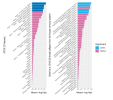They're just different methods of predicting the important genes, so the results won't be exactly the same. (Again, keep in mind those 13 genes aren't necessarily related to the brain enrichment.)How are we to reconcile the somewhat different genes and tissues of:
Fig. 3. MAGMA gene-tissue analysis shows statistically significant enrichment of ME/CFS-related genes in all 13 brain tissues.
Fig. 4: Approximate Bayes factor posterior probability (PPH4) that mRNA expression and ME/CFS traits are associated and share a single causal variant.
The candidate genes were determined based on genes known to be differentially expressed due to a significant variant. The 13 MAGMA genes were basically just the genes with the most highly significant variants nearby.
Lots of the candidate genes in fig. 4 show brain expression, so I don't see a disconnect with the tissue enrichment part.

